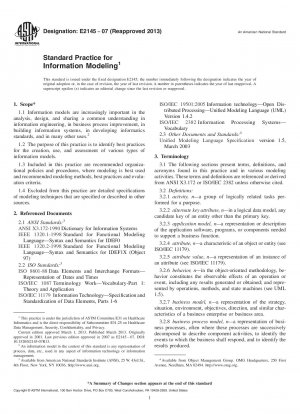ASTM E2145-07(2013)
Standard Practice for Information Modeling
- Standard No.
- ASTM E2145-07(2013)
- Release Date
- 2007
- Published By
- American Society for Testing and Materials (ASTM)
- Latest
- ASTM E2145-07(2013)
- Scope
5.1 Modeling is increasingly used in business, industry, and commerce to develop a common understanding of processes, functions, activities, and supporting data. Typical users of such models are systems developers, operations researchers and business analysts, educators, and executives.
5.1.1 Information models are regarded widely as beneficial by saving cost through realignment of processes, risk reduction and elimination of redundancy. Information models convey ideas and facilitate the analysis and understanding of complex processes and structures. These models form the basis for software engineering practices that build systems and databases, redefine organizational structures, improve business processes, and develop standards.
5.2.1 Models are representations of past, existing, or contemplated reality. Models may assist in the explanation or analysis of complex structures and processes that may exceed human capacity for direct visualization or understanding. Models enable a focus on the key elements of a process or structure while ignoring confounding or irrelevant elements. As such, models make an explicit statement of the meaning of the reality being modeled.
5.2.2 Integrated information engineering models provide a coherent view of the processes and data of an organization or enterprise (5). Activity models identify the fundamental tasks performed in a function. Process models accurately describe the detailed collection of these activities within an organization. Data models are derived from and support the functions described in activity models. Object models also characterize the processes and data required to understand business operations. Both structured and object-oriented models may be used to construct information systems that support those business operations. Application models describe in varying levels of detail, the overall architecture and components of the software needed to support the envisioned business functions. Organizational models reflect the current and envisioned future state of the organization, especially as this impacts business processes enabled or supported by information systems. Location models identify and describe the business and geographic position and relationships of structural components of an organizational entity. Technology models describe in varying levels of detail those hardware, system software, and network components needed to operate the information systems supporting a business area.
Models may be textual, graphic, or mixed graphic and text forms, including, tables and structured lists, flowcharts, process flow diagrams, state diagrams, data flow diagrams, entity-relationship diagrams, and related techniques develop an understanding of business processes and the transformation of data through these processes (6). Modeling products may also relate two or more types of models, such as for an Application-Data Matrix, or Technology-Location Plan.
......
ASTM E2145-07(2013) Referenced Document
- IEEE 1320.1-1998 Standard for Functional Modeling Language - Syntax and Semantics for IDEF0 IEEE Computer Society Document
- IEEE 1320.2-1998 Standard for Conceptual Modeling Language Syntax and Semantics for IDEF1X97 (IDEFobject) IEEE Computer Society Document
- ISO/IEC 11179 Information technology — Metadata registries (MDR) — Part 7: Metamodel for data set registration
- ISO/IEC 2382 Information technology - Vocabulary
ASTM E2145-07(2013) history
- 2007 ASTM E2145-07(2013) Standard Practice for Information Modeling
- 2007 ASTM E2145-07 Standard Practice for Information Modeling
- 2001 ASTM E2145-01 Standard Practice for Modeling in Health Informatics

Copyright ©2024 All Rights Reserved